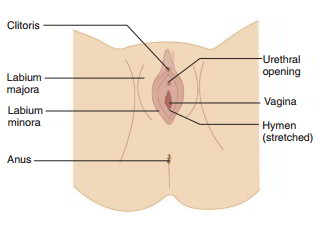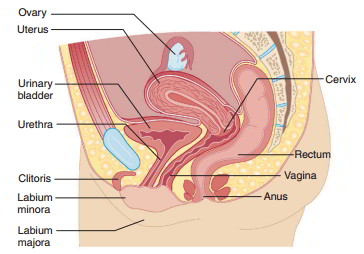The female reproductive system produces female sex hormones and female sex cells and transports the sex cells to a site where they may unite with sperm. In addition, the female reproductive system provides a suitable environment for the development of the embryo and fetus and is actively involved in the birth process. The organs of the female reproductive system include the paired ovaries, which produce female sex hormones and sex cells; paired uterine tubes, which transport the female sex cells; a uterus, where internal development of the embryo and fetus occurs; a vagina, which serves as the female cop- ulatory organ and birth canal; and the external genitalia. The uterine tubes, the uterus, and the vagina are collectively referred to as the female reproductive tract.
Ovaries
The ovaries are located in the superior, lateral portions of the pelvic cavity, one on each side of the uterus. They are about the same size and shape as large almonds, and they are supported by several ligaments. The external surface of an ovary is covered by the ovarian mesothelium. Deep to the ovarian mesothelium is a more dense region, which contains ovarian follicles of various sizes. Each ovarian follicle is a spherical structure composed of an oocyte enveloped by supporting cells. An oocyte is an immature ovum. The internal region of an ovary consists of areolar connective tissue that supports nerves and blood vessels.
Oogenesis
Oogenesis (o-o-jenf-e-sis) is the process of producing ova (singular, ovum). Oogenesis is similar to spermatogenesis with a few notable exceptions.
By the fifth month of fetal development of a human female, the ovaries contain several million oogonia (o-o-go-ne-ah), the stem cells of the ovaries. Gradually, most of the oogonia mature into primary oocytes (o-o-sitz) surrounded by a single layer of squamous follicular epithelial cells forming the primordial ovarian follicles. When a female is born, the infant’s ovaries lack oogonia and contain about 2 million primary oocytes within primordial ovarian follicles. Primary oocytes contain 46 chromosomes, so they are capable of meiotic cell division. Starting at puberty, a few primordial ovarian follicles are activated each month. The development of the oocyte and ovarian follicle takes nearly a year to complete. However, only one of the primary oocytes will complete meiosis I each month.
Chromosomes are replicated prior to meiosis I and line up as homologous pairs at metaphase. Each chromosome consists of two chromatids joined by the centromere. In meiosis I, the primary oocyte divides to form two dissimilar cells, each with only 23 chromosomes. Only one member of each chromosome pair is distributed to each daughter cell. The smaller cell, the first polar body, contains almost no cytoplasm and performs no further function. It is formed as a convenient way to get rid of 23 chromosomes. The larger cell is the secondary oocyte, and it contains nearly all of the cytoplasm that was present in the primary oocyte. It is the secondary oocyte that is released from an ovary each month during a female’s reproductive life. Ovulation is the process of an ovary releasing a secondary oocyte. As in spermatogenesis, the genetic diversity of the secondary oocytes results from the random alignment of the paired homologous chromosomes and the crossover between the paired homologous chromosomes during meiosis I.
Meiosis II is completed only if the secondary oocyte is penetrated by a sperm. Meiosis II forms another polar body and an ovum, which receives nearly all of the cytoplasm.
The chromatids of each chromosome separate, and they are distributed into different daughter cells. Therefore, both ovum and second polar body contain 23 chromosomes. The fusion of ovum nucleus and sperm nucleus forms a zygote, the first cell of a preembryo. The polar bodies simply degenerate.
Uterine Tubes
The paired uterine tubes receive and transport the secondary oocyte, are the sites of fertilization, and transport the preembryo if fertilization occurs. Each uterine tube extends laterally from the superior lateral surface of the uterus to an ovary. The lateral end of each tube forms a funnel-shaped expansion, the infundibulum (in-fun-dib f-u-lum), that partially envelops an ovary but is not connected to it. Each infundibulum is subdivided into a number of fingerlike processes called fimbriae (fim’-bre-e) that may touch the ovary.
The internal lining of a uterine tube consists of simple ciliated columnar epithelium and secretory cells. The beating of the cilia creates a current that helps draw the ovulated secondary oocyte into the infundibulum. Then, the beating cilia and the peristaltic contractions of the uterine tube move the oocyte slowly toward the uterus.
Uterus
The uterus (uf-ter-us) is located in the pelvic cavity posterior to the urinary bladder. It is located superior to the vagina and is bent anteriorly over the urinary bladder. The uterus is a hollow organ with thick, muscular walls. Its primary function is to provide an appropriate internal environment for a developing embryo and fetus.
The uterus has three major regions. The fundus, the superior rounded region, joins with the uterine tubes laterally. The body, the middle portion, is enlarged and rounded. The cervix, the inferior tubular portion, is inserted into the superior end of the vagina.
The walls of the uterus are composed of three layers. The endometrium (en-do-mef-tre-um), the mucosal layer, is the internal layer of the uterus. The myometrium is the thick layer of smooth muscle that forms most of the wall thickness. The perimetrium, the serous layer, is the external layer of the uterus.
Vagina
The vagina is the collapsible tube that extends from the uterus to the external environment. It serves as the female copulatory organ and the birth canal. The vagina is located posterior to the urethra and anterior to the rectum. The vaginal wall consists of three layers: an internal mucosa of stratified squamous epithelium and areolar connective tissue, a thin layer of smooth muscle, and an external layer of dense irregular connective tissue.
Female External Genitalia
The orifices of the urethra and vagina are surrounded by the female external genitalia, or vulva. The portion of the perineum between the vaginal orifice and the anus is often called the obstetrical perineum. It is so named because this tissue is often torn during childbirth.
The paired labia majora (la’-be–-ah ma-jo’-rah) (singular, labium majus) are rounded longitudinal folds of adipose tissue and a thin layer of smooth muscle covered by skin. The labia majora enclose the other external genitalia, and their medial margins are separated by a narrow cleft. They join anteriorly at the mons pubis, a rounded cushion of adipose tissue over the anterior surface of the pubic symphysis. The labia majora are formed of the same embryonic tissues that form the scrotum in males.
The labia minora (singular, labium minus) are paired, thinner, longitudinal folds that lie medial to the labia majora. They join anteriorly to form a hoodlike covering over the clitoris. Posteriorly, they join with the labia majora.
The narrow space between the labia minora is known as the vestibule. The urethra opens into its anterior region, and the vagina opens into its posterior region. The female external genitalia contain the same erectile tissues as the male penis. The bulbs of the vestibule are composed of corpus spongiosum and are located deep to the labia minora surrounding the distal vagina. They become engorged with blood and are involved in the female sexual response.
The vestibular (Bartholin’s) glands lie posterior to the bulbs on each side of the vaginal orifice and release their secretions into the vestibule. The clitoris (kli’-to-r-is) is formed of two columns of corpora cavernosa that extend bilaterally near the pubis. The glans of the clitoris is formed by the union of the two columns of the clitoris. The glans is the only portion of the female erectile tissues that is visible in the perineum and
is located at the anterior junction of the labia minora. The glans contains abundant sensory receptors that are involved in the female sexual response.
Summary of Functions of Female Reproductive Organs
| Organ | Function |
| Ovary | The site of oocyte production and maturation; secretes estrogens, progesterone, and inhibin |
| Uterine tube | Receives and transports secondary oocyte, site of fertilization; carries the preembryo if fertilization occurs |
| Uterus | Provides an appropriate internal environment for the development of embryo and fetus during pregnancy |
| Vagina | Serves as the copulatory organ and birth canal |
| Labia majora | Protect other female external genitalia |
| Labia minora | Enclose vestibule; protect vaginal and urethral orifices |
| Clitoris | Contains sensory receptors associated with feelings of sexual pleasure |
| Bulbs of the vestibule | Erectile tissue of the vestibule that fills with blood during sexual stimulation |
| Vestibular glands | Secrete fluid that lubricates vaginal orifice and vestibule during sexual stimulation |




 (69 votes, average: 3.71 out of 5)
(69 votes, average: 3.71 out of 5)